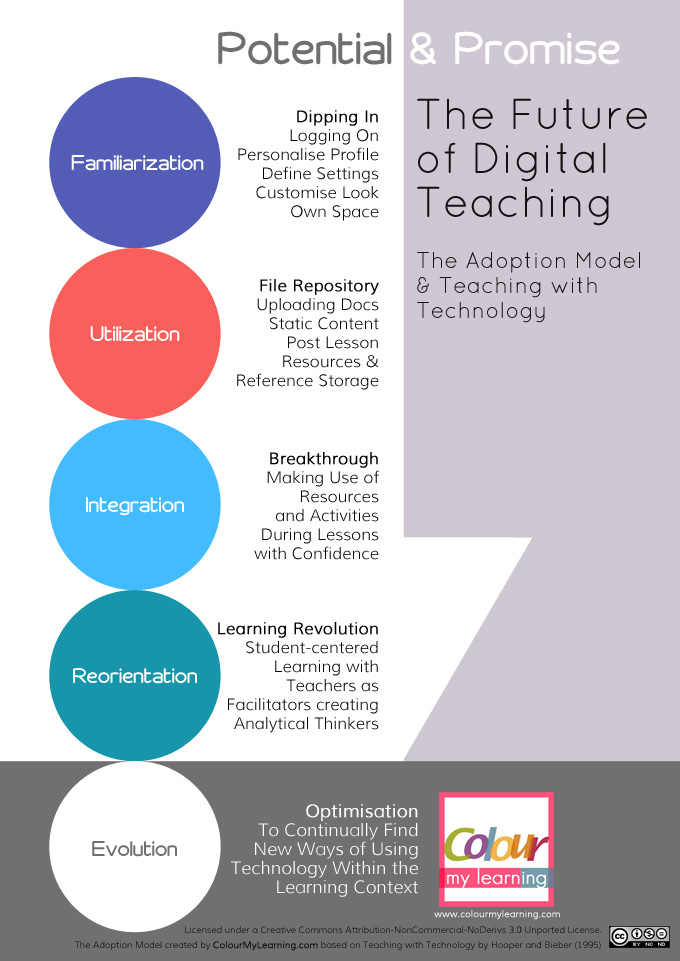Potential and Promise – the Future of Digital Teaching
A BBC article (Costly hi-tech kit lies unused in schools, says study) recently highlighted the findings of a report Decoding Learning by Nesta (National Endowment for Science, Technology and the Arts).
The report acknowledged that while technology in teaching shows much potential and carries even greater promise, the heart of this revolution lies very much with teachers being able to cross the chasm between simply ‘having’ pieces of advanced technological kit to genuinely being able to make the ‘best use’ of the same kit, not only to enhance the learning experience but also to enable learning to be a constant, continuous process.
In our experience with training teachers to use VLEs (via Xelium) we have found this transition, to take place in a step-wise fashion.
We highlight here the 5 phases of teaching with technology as we have observed from our experience and have compared it to the Model of Adoption (Teaching with Technology, proposed by Hooper and Rieber (1995) Hooper, S., & Rieber, L. P. (1995). Teaching with technology. In A. C. Ornstein (Ed.), Teaching: Theory into practice, (pp. 154-170). Needham Heights, MA: Allyn and Bacon.)
| Model of Adoption | VLE Use | |
| 1. | Familiarization | Dipping In:Early experimentation on VLEs often consist of logging in, personalising a profile. Defining some settings which make the look and feel of personal pages more familiar allowing users to ‘own’ a space. |
| 2. | Utilization | Repository:The first stages of utilization of the VLE often falls in to using the VLE as a ‘storage space’. A file repository in which Powerpoint files and Word documents are uploaded to allow students access after the lesson has been taught.The early utilizers often do not make use of technology within class time, but point their students to an online space where teaching materials and learning content from the lesson has been stored. |
| 3. | Integration | Full-time: This next stage of development, described as the ‘break through’ phase, takes the teacher from simply uploading and storing files on the VLE to actually making use of these and some other resources during lesson time.The integration of VLE use during classroom time evolves with the ever-growing confidence of the teacher and a solid dependable IT system. While it often takes a little bit of time for most teachers to move from Utilization to the Integration stage, most gradually ‘get there’ so long as the necessary support systems are in place. |
| 4. | Reorientation | The Learning Revolution: This reorientation phase, as described in the Model of Adoption is perhaps THE most important of all ‘learning with technology’ stages. It is here that teachers ‘reconstruct’ the meaning of pedagogy in the face of technology. The focus on teaching shifts towards student-centred learning. This is when teachers become ready to ‘facilitate’ learning instead of simply being arbitrators of knowledge. Here, support is provided by the teacher on ‘how to…’ but also where the teacher readily admits that they are not the expert, and thus is learning alongside the students. This is potentially the largest jump of all and takes a lot of confidence and a significant amount of trust both in your own skills as a teacher but also in the fact that the students will learn what they need to know, perhaps in their own way.The significance of this stage is that we will start to produce not students who are simply able to regurgitate facts and figures but thinking, analytical students who are able to pose questions and search for answers. |
| 5. | Evolution | Optimisation: This stage as describe within Hooper and Rieber’s article revolves around the ability of both educators and the education system to continuously evolve to optimise the use of technology within the learning context. |
Do you recognise yourself at any of these stages? Do you need help to progress to the next stage? Have you any tips to share on how to move forward?
Feel free to get in touch with us either by leaving a comment or emailing us, we look forward to hearing from you.
Author: Li-ling, tweets as DrOoi and is passionate about all things learning.
Graphic Created by Samuel J Tan

Adoption Model – Teaching with Technology by CML is licensed under a Creative Commons Attribution-NonCommercial-NoDerivs 3.0 Unported License.
Based on a work at www.colourmylearning.com.
You will benefit from a newsletter updates straight to your mailbox from ColourMyLearning on the use of Technology for Teaching and Learning.
Don’t forget to rate this article












The Adoption Model for Technology and VLE | Colour My Learning
November 22, 2012 @ 11:01 am
[…] The Adoption Model for Technology and VLE by Colour My Learning on Nov 22, 2012 • 11:00 am Comments The Adoption Model below looks at the 5 stages of Teaching with Technology and the Future of Digital Teaching. […]
November 26, 2012 @ 2:36 pm
Good stuff! Realised that i’ve been on this for a while without knowing that there’s a name for it. i noticed that kids (Malaysian ones) know their tech but take them for granted that they barely scratch the surface of empowering possibilities.
& this is why i ‘fight’ to include the topic ‘Use of Tech’ in academic English.
November 27, 2012 @ 9:28 am
Thank you Brendan. It’s really good to hear that you’re working hard to move teaching with tech forward. It’s takes a brave teacher to do that. All the best to you!
Introverts, Susan Cain, The Quiet Revolution, e-learning | Colour My Learning
December 10, 2012 @ 4:39 pm
[…] excellent blog Spicy Learning. While I was really amazed at his thoughts and methods for technology Reorientation in his English classes, he also shared in this post a quick survey among his students on their […]
3 Simple Ways to Integrate Technology into Teaching: Beyond Utilisation | Colour My Learning
September 24, 2013 @ 8:21 pm
[…] This particular school has been using Moodle for a while now, but mainly as a file repository (which we as the Utilisation stage in our article on the Adoption Model for Technology and VLE described in more detail here. […]